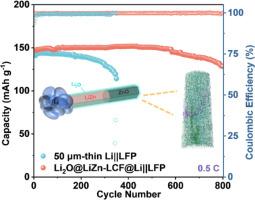面向实用锂金属电池的双亲锂性Li2O@LiZn站点
IF 9.3
1区 材料科学
Q1 MATERIALS SCIENCE, MULTIDISCIPLINARY
引用次数: 0
摘要
锂金属负极以其超高的比容量被认为是锂金属电池负极材料的“圣杯”。然而,“无主”锂枝晶在锂阳极中的不可控生长对其实际应用有着至关重要的影响。本文提出了一种超轻量化的3D碳纤维,利用ZnO纳米珊瑚辅助熔融锂注入来构建锂金属阳极。原子探针层析成像(APT)表明,Li可以在原子尺度上掺杂到Zn中,并在ZnO纳米珊瑚上形成Li2O,实现了强亲锂界面的均匀锂沉积。原位TEM和DFT计算证实,形成的LiZn/Li2O不仅作为降低Li扩散势垒的成核位点,而且提高了界面离子电导率,使Li离子通量均匀化。结果表明,在超高锂利用率为70.7 %的情况下,Li2O@LiZn-LCF@Li阳极在400 h内表现出优异的循环稳定性。在恶劣的低N/P(2.08)条件下,与LiFePO4配对的电池可提供142.9 mAh g−1的高放电容量,并在100次循环后保持93.3 %的高容量保留率。该策略为在实际高能量密度lmb中开发复合金属阳极提供了广阔的前景。本文章由计算机程序翻译,如有差异,请以英文原文为准。

Dual Lithiophilic Li2O@LiZn sites towards practical Lithium metal batteries
Lithium metal anode is regarded as the “holy grail” of anode materials for Li-metal batteries (LMBs) because of its ultrahigh-specific capacity. However, the uncontrollable growth of “hostless” Li dendrite in the Li anode has a vital impact on its practical applications. Herein, the ultra-lightweight 3D carbon fiber is proposed to construct a Li metal anode via molten Li infusion with the aid of ZnO nano-coral. The atom probe tomograph (APT) manifests that the Li can be doped into Zn at the atomic scale and form Li2O on ZnO nano-coral, realizing a strong lithiophilic interface for uniform Li deposition. The in-situ TEM and DFT calculation confirms that the formed LiZn/Li2O not only acts as nucleation sites for lowering the Li diffusion barrier but also improves interfacial ionic conductivity for homogenizing Li-ion flux. As a result, the Li2O@LiZn-LCF@Li anode exhibits excellent cycle stability over 400 h under ultrahigh Li utilization of 70.7 %. The full cell paired with LiFePO4 delivers a high discharge capacity of 142.9 mAh g−1 and maintains a high-capacity retention of 93.3 % after 100 cycles under a harsh condition of low N/P (2.08). The strategy provides a broad prospect for developing composite metal anodes in practical high-energy-density LMBs.
求助全文
通过发布文献求助,成功后即可免费获取论文全文。
去求助
来源期刊

Acta Materialia
工程技术-材料科学:综合
CiteScore
16.10
自引率
8.50%
发文量
801
审稿时长
53 days
期刊介绍:
Acta Materialia serves as a platform for publishing full-length, original papers and commissioned overviews that contribute to a profound understanding of the correlation between the processing, structure, and properties of inorganic materials. The journal seeks papers with high impact potential or those that significantly propel the field forward. The scope includes the atomic and molecular arrangements, chemical and electronic structures, and microstructure of materials, focusing on their mechanical or functional behavior across all length scales, including nanostructures.
 求助内容:
求助内容: 应助结果提醒方式:
应助结果提醒方式:


